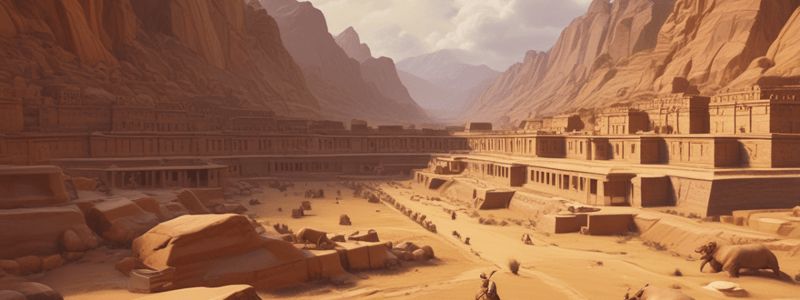Podcast
Questions and Answers
What is the primary source of evidence for understanding the Harappan civilisation?
What is the primary source of evidence for understanding the Harappan civilisation?
- Oral traditions and stories
- Ancient texts and manuscripts
- Material evidence such as pottery and tools (correct)
- The Harappan script
Why do organic materials such as cloth and leather rarely survive?
Why do organic materials such as cloth and leather rarely survive?
- Because they decompose quickly in tropical regions (correct)
- Because they are often destroyed on purpose
- Because they are not made of durable materials
- Because they are not valuable
What is the significance of finding valuable artefacts intact?
What is the significance of finding valuable artefacts intact?
- They were lost in the past or hoarded and never retrieved (correct)
- They were made of durable materials
- They were deliberately buried for archaeological discovery
- They were used for ritual purposes
What is one principle of classification used by archaeologists?
What is one principle of classification used by archaeologists?
How do archaeologists determine the function of an artefact?
How do archaeologists determine the function of an artefact?
Why do archaeologists classify their finds?
Why do archaeologists classify their finds?
What is the name of the standard that the local 'Dilmun' weights followed?
What is the name of the standard that the local 'Dilmun' weights followed?
What is the term used to describe the build-up of occupational debris over time?
What is the term used to describe the build-up of occupational debris over time?
What is the purpose of studying the layers in an archaeological site?
What is the purpose of studying the layers in an archaeological site?
What is the term used to describe the absence of ancient materials in a layer?
What is the term used to describe the absence of ancient materials in a layer?
What was the occupation of the 'punka-walla' mentioned in Wheeler's account?
What was the occupation of the 'punka-walla' mentioned in Wheeler's account?
What are the claims of shamans, according to the text?
What are the claims of shamans, according to the text?
What is the term used by archaeologists to describe a group of objects, distinctive in style, that are usually found together within a specific geographical area and period of time?
What is the term used by archaeologists to describe a group of objects, distinctive in style, that are usually found together within a specific geographical area and period of time?
What does the term 'BP' stand for in the context of archaeological dating?
What does the term 'BP' stand for in the context of archaeological dating?
What is the name of the site where the Harappan culture was first discovered?
What is the name of the site where the Harappan culture was first discovered?
What is the term used to describe the process of understanding ancient artefacts by comparing them with present-day analogies?
What is the term used to describe the process of understanding ancient artefacts by comparing them with present-day analogies?
What is the name of the first Director-General of the Archaeological Survey of India (ASI)?
What is the name of the first Director-General of the Archaeological Survey of India (ASI)?
What is the term used to describe the period of time between c. 2600 and 1900 BCE?
What is the term used to describe the period of time between c. 2600 and 1900 BCE?
What is the term used to describe objects kept carefully by people, often inside containers such as pots?
What is the term used to describe objects kept carefully by people, often inside containers such as pots?
What is the name of the site where the entire settlement was fortified, and sections within the town were also separated by walls?
What is the name of the site where the entire settlement was fortified, and sections within the town were also separated by walls?
What is the term used to describe the first use of copper in archaeology?
What is the term used to describe the first use of copper in archaeology?
What is the name of the seal found in Bahrain that sometimes carries Harappan motifs?
What is the name of the seal found in Bahrain that sometimes carries Harappan motifs?
What is the significance of the context in which an artefact was found in archaeology?
What is the significance of the context in which an artefact was found in archaeology?
What is the basis of the identification of the 'priest-king' in Harappan archaeology?
What is the basis of the identification of the 'priest-king' in Harappan archaeology?
Why do archaeologists often move from the known to the unknown when reconstructing Harappan religion?
Why do archaeologists often move from the known to the unknown when reconstructing Harappan religion?
What is the significance of the 'proto-Shiva' seals in Harappan archaeology?
What is the significance of the 'proto-Shiva' seals in Harappan archaeology?
What is the limitation of relying on later traditions to reconstruct Harappan religion?
What is the limitation of relying on later traditions to reconstruct Harappan religion?
What has been achieved after many decades of archaeological work on the Harappans?
What has been achieved after many decades of archaeological work on the Harappans?
What is the significance of the Rigveda in reconstructing Harappan religion?
What is the significance of the Rigveda in reconstructing Harappan religion?
What is the significance of the 'unicorn' in Harappan archaeology?
What is the significance of the 'unicorn' in Harappan archaeology?
What is the uncertainty regarding the Harappan cemeteries?
What is the uncertainty regarding the Harappan cemeteries?
What is the uncertainty regarding the terracotta female figurines?
What is the uncertainty regarding the terracotta female figurines?
Flashcards are hidden until you start studying




